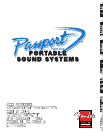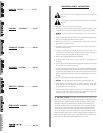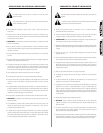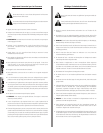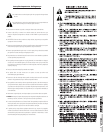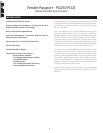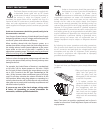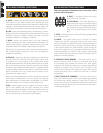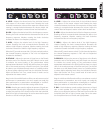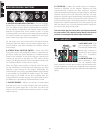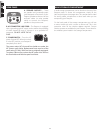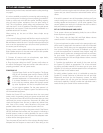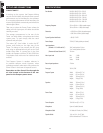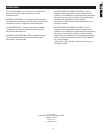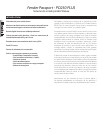
8
A. LEVEL Adjusts the volume level of the individual channel
with respect to the master volume level. Rotating the knob
clockwise increases the volume of the respective channel, while
rotating it counterclockwise decreases the volume. Adjust this
control after the Passport’s master volume level has been set.
B. LOW – Adjusts the relative level of the low frequency content.
Rotating the knob counterclockwise decreases the bass or low
frequency response. Likewise, rotating the knob clockwise
increases the bass or low frequency response.
C. HIGH – Adjusts the relative level of the high frequency
content. Rotating the knob counterclockwise decreases the
treble or high frequency response. Likewise, rotating the knob
clockwise increases the treble or high frequency response.
When the EQ controls are set at their 12 o'clock notched position,
the channel frequency response is “flat” with no frequencies
increased or decreased.
D. REV/AUX Adjusts the amount of signal sent to the Reverb
processor, and to the Rev/Aux send jack. Reverb can be used
to enhance the sound quality of any performance where
appropriate and desired. In the full left position there is no signal
sent to the reverb processor or Rev/Aux send jack. Care should
be taken to set the Master Reverb control to a middle position
or above, before adjusting levels from the individual channels.
When the Rev/Aux mix is set, overall levels of reverb can be
adjusted at the master control.
Keep in mind that while Reverb or effects can enhance a musical
performance or presentation, too much reverb can make the
same performance or presentation unintelligible or “muffled”.
Keep your audience in mind when setting reverb levels.
E. BAL – Use the balance control to adjust the amount of signal
sent to each speaker (left and right). Adjusting this control
allows you to adjust the position of the sound source within the
horizontal plane, left or right of center stage. Set to the center
dot for equal amounts to the left and right speakers.
(Note: All operations listed below occur only when a CD is
present within the player.)
A. EJECT – This button allows you to eject
your CD from the CD player.
B. PLAY/PAUSE – This button allows you to
begin play of a CD once it is inserted. Pushing
this button while a CD is being played allows
you to pause the track. Pushing this button
while a CD is paused allows you to resume
play.
C. STOP – Pushing this button while a CD is being played allows
you to stop the track.
D. MODE
– This button allows you to use the CD player's
"repeat" and "shuffle" commands. Pushing this button once
puts the CD player in "repeat track" mode, causing the player to
repeat the current track once it is through. Pushing the button
a second time begins the "repeat album" mode, causing the
entire CD to repeat once it is completed. Pushing the button
a third time begins the "shuffle" mode, causing a random play
order of tracks. Pushing the button a fourth time returns the CD
player to its normal operation.
E. PREVIOUS TRACK/REWIND
– This button allows you to
restart or rewind a track, or return to a previous track. Once
a track begins play, pushing the button once then quickly
releasing it will restart the track that is currently being played.
Pushing the button twice will return the CD player to the
previous track. Pressing and holding this button down during
normal play allows you to rewind the track that is currently
being played.
F. NEXT TRACK/FAST FORWARD – This button allows you to
skip or fast forward a track. Once a track begins play, pushing
this button then quickly releasing it causes the CD player to
jump to the next track. Pressing and holding this button down
during normal play allows you to fast forward the track that is
currently being played.
cd player coNtrol fuNctIoNS cd player ButtoN fuNctIoNS



